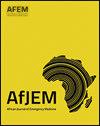The effect of smartphones and mobile apps in Egyptian Emergency Departments: A cross-sectional study
IF 1.2
4区 医学
Q3 EMERGENCY MEDICINE
引用次数: 0
Abstract
Background
The prevalence of mobile devices in healthcare environments has steeply increased the creation of medical software applications, or apps, for these platforms. It can enhance the provided healthcare services.
Aim
This study aimed to assess the prevalence of smartphone use among health care professionals (HCPs) in Egypt and detect the possible benefits and challenges identified by HCPs in the emergency department associated with the use of smartphones and mobile apps.
Methods
A cross-sectional 23-question structured survey-based study was conducted and distributed electronically via GoogleForms. The survey targeted all healthcare professionals working in emergency departments in Egypt either from University hospitals or the Ministry of Health.
Results
Among 130 responders, almost 89 % were physicians, while the rest were nurses. In addition, 53.1 % had one to four years of experience. Our study revealed that 62.3 % of the responders used medical apps daily with 61.5 % using smartphones during their work shifts. Though, about 81.5 % demonstrated limited or no availability of necessary technology infrastructure in ED. Furthermore, peer-reviewed evidence use was detected among 80 % of the responders using Google and other search engines for health-related information, and about 23 % of them used WikiEM and Wikipedia. Nevertheless, Medscape, MedCalc, and Up-to-date were among the most used medical apps with 69.2 %, 44.6 %, and 33.1 % respectively. Most of the responders were confident that smartphones could improve patient safety. In addition, satisfaction with current mobile apps was detected by more than 60 %, and most of the HCPs agreed that smartphones and mobile apps are crucial for future emergency healthcare delivery.
Conclusion
The use of smartphone apps in Egyptian ED is critical and is widespread among health providers; however, proper training on peer-reviewed resources can serve in improving medical health services.
智能手机和移动应用程序对埃及急诊科的影响:一项横断面研究
背景:移动设备在医疗环境中的普及大大增加了针对这些平台的医疗软件应用程序(app)的创建。它可以增强所提供的医疗保健服务。目的本研究旨在评估埃及卫生保健专业人员(HCPs)使用智能手机的流行程度,并检测急诊部门卫生保健专业人员发现的与智能手机和移动应用程序使用相关的可能益处和挑战。方法采用横断面23个问题的结构化调查研究,并通过GoogleForms进行电子分发。该调查的对象是在埃及大学医院或卫生部急诊科工作的所有医疗保健专业人员。结果在130名应答者中,近89%为医生,其余为护士。此外,53.1%的人有一到四年的工作经验。我们的研究显示,62.3%的应答者每天使用医疗应用程序,61.5%的人在轮班期间使用智能手机。尽管如此,大约81.5%的人在ED中表现出有限或没有必要的技术基础设施。此外,80%的应答者使用b谷歌和其他与健康相关的信息搜索引擎检测到同行评议的证据,其中约23%的人使用WikiEM和Wikipedia。然而,Medscape、MedCalc和updated是使用率最高的医疗应用程序,分别占69.2%、44.6%和33.1%。大多数应答者都相信智能手机可以改善患者的安全。此外,超过60%的人对当前的移动应用程序感到满意,大多数医护人员都认为智能手机和移动应用程序对未来的紧急医疗服务至关重要。结论智能手机应用程序在埃及急诊科的使用至关重要,并且在卫生服务提供者中广泛使用;但是,对同行评议资源进行适当培训有助于改善医疗保健服务。
本文章由计算机程序翻译,如有差异,请以英文原文为准。
求助全文
约1分钟内获得全文
求助全文
来源期刊

African Journal of Emergency Medicine
EMERGENCY MEDICINE-
CiteScore
2.40
自引率
7.70%
发文量
78
审稿时长
85 days
 求助内容:
求助内容: 应助结果提醒方式:
应助结果提醒方式:


